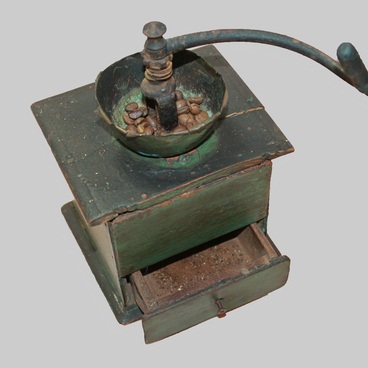The manual coffee grinder presented in the museum’s collection is made of wood and sheet metal painted brown. At the end of the metal handle, there is a shaped element made of wood. A special funnel for grinding grains is made of porcelain. For ground coffee beans, there is a small beech drawer at the bottom of the device. The actual working part, i.e. the millstone, is mounted in a beech die, which is attached to the top cover of the coffee grinder. The lower millstone is stationary, with the only upper millstone rotating in the form of a ball. The principle of operation of the device is as follows: the handle drives the millstone, the coffee is ground with teeth, and the ground grains are poured into the drawer.
It is difficult to say when such instances of coffee grinders appeared in the Urals and how common they were. The local Russian population before the revolution definitely adhered to tea traditions. But the intelligentsia and foreigners who permanently live in Yekaterinburg and Chelyabinsk at the turn of the 20th century, most likely, were already actively drinking “kofiy”. That is how this drink was called earlier. There were few coffee shops in the cities. It is possible that some coffee grinders remained in the Urals from the time of those coffee shops, but probably the vast majority of old coffee grinders here are trophies brought after the Great Patriotic War, or purchases from European flea markets.
The first Russian coffee lover was tsar Peter the Great who became addicted to coffee in Holland during the Great Embassy’s trip to Europe in 1697. At that time, this drink was credited with amazing medicinal properties and was sold in pharmacies. After returning to Russia, Peter issued a special decree ordering all subjects to drink coffee both in private and at official assemblies. The conservative part of society took this innovation badly, similarly to the rest of Peter the Great’s measures for the transition to a European way of life.
In 1724, inns for foreigners where coffee was served, among other things, appeared in St. Petersburg. The first coffee house in Russia was opened in 1740 by a personal decree of the Empress Anne of Russia, a fan of this drink. She always started every morning with a cup of coffee served directly to her bed.
It is difficult to say when such instances of coffee grinders appeared in the Urals and how common they were. The local Russian population before the revolution definitely adhered to tea traditions. But the intelligentsia and foreigners who permanently live in Yekaterinburg and Chelyabinsk at the turn of the 20th century, most likely, were already actively drinking “kofiy”. That is how this drink was called earlier. There were few coffee shops in the cities. It is possible that some coffee grinders remained in the Urals from the time of those coffee shops, but probably the vast majority of old coffee grinders here are trophies brought after the Great Patriotic War, or purchases from European flea markets.
The first Russian coffee lover was tsar Peter the Great who became addicted to coffee in Holland during the Great Embassy’s trip to Europe in 1697. At that time, this drink was credited with amazing medicinal properties and was sold in pharmacies. After returning to Russia, Peter issued a special decree ordering all subjects to drink coffee both in private and at official assemblies. The conservative part of society took this innovation badly, similarly to the rest of Peter the Great’s measures for the transition to a European way of life.
In 1724, inns for foreigners where coffee was served, among other things, appeared in St. Petersburg. The first coffee house in Russia was opened in 1740 by a personal decree of the Empress Anne of Russia, a fan of this drink. She always started every morning with a cup of coffee served directly to her bed.



